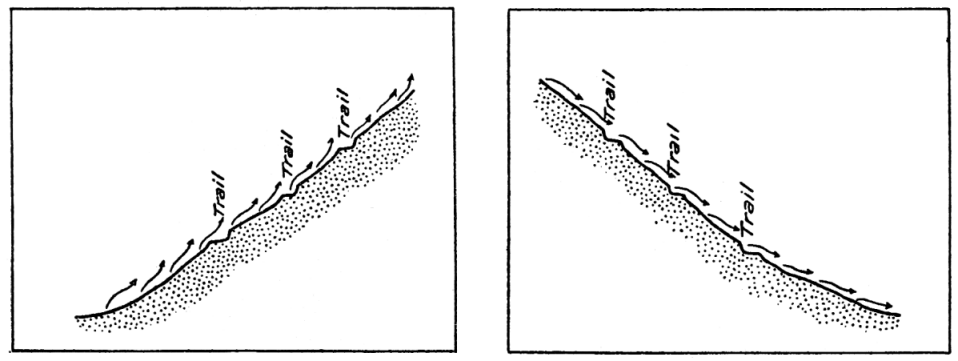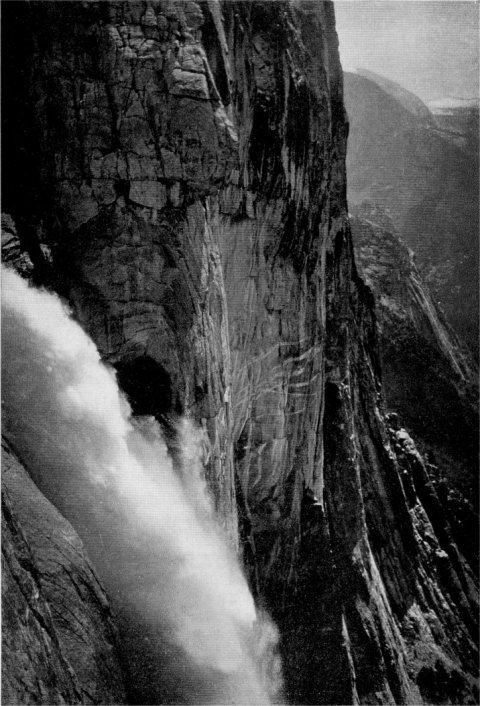
[click to enlarge]
Upper Yosemite Fall. By Ansel Adams
| Online Library: | Title | Author | California | Geology | History | Indians | Muir | Mountaineering | Nature | Management |
Yosemite > Library > François Matthes > The Winds of the Yosemite Valley >
Next: Striped Rock Floor • Contents • Previous: François Emile Matthes
THE MARKS OF TIME |

[click to enlarge] Upper Yosemite Fall. By Ansel Adams |
To most people roaming about the Yosemite Valley its winds and breezes seem a matter of small interest or consequence. They come and go, now one way, now another, apparently without regularity or system—moody, capricious beyond analysis. In the midst of the grand tumult of the Yosemite landscape, our senses fairly bewildered with its many glories, we cannot stop to consider these little breaths that blow about us, and let them puff by unheeded. The Yosemite region is not a windy country anyway; but once or twice in a season does a gale arise to disturb its wonted tranquillity, and its daily zephyrs are such light, airy little nothings as to scarcely seem worthy of downright study. And yet they become singularly interesting when once rightly understood. They turn out to be surprisingly systematic and withal so intimately connected with the configuration of the valley itself, that, to one who has at length mastered their secret they grow to be one of its immanent features, as characteristic and inseparable as El Capitan or the Yosemite Falls.
It happens to be so ordained in nature that the sun shall heat the ground more rapidly than the air. And so it comes that every slope or hillside basking in the morning sun soon becomes itself a source of heat. It gradually warms the air immediately over it, and the latter, becoming lighter, begins to rise. But not vertically upward, for above it is still the cool air pressing down. Up along the warm slope it ascends, much as shown by the arrows in the accompanying diagram (Fig. 1). Few visitors to the valley but will remember toiling up some never-ending zigzags on a hot and breathless day, with the sun on their backs and their own dust floating upward with them in an exasperating, choking cloud. Perhaps they thought it was simply their misfortune that the dust should happen to rise on that particular day. It always does on a sun-warmed slope.
But again, memories may arise of another occasion when, on coming down a certain trail the dust ever descended with the travelers, wafting down upon them from zigzag to zigzag as if with malicious pleasure. That, however, undoubtedly happened on the shady side of the valley. For there the conditions are exactly reversed. When the sun leaves a slope the latter begins at once to lose its heat by radiation, and in a short time is colder than the air. The layer next to the ground then gradually chills by contact, and, becoming heavier

[click to enlarge] Figure 1 Figure 2 |
But, it may be objected, the valley sides lie ever part in the sun, part in shadow. The very lay and configuration of the valley are such that at no hour of the day is either of its slopes entirely sunlit; what with the many cliffs and headlands and recesses there is always a shadow here or there. Is there, then, really an updraft wherever the sun shines and a downdraft in every shadow patch? Most assuredly there is. That is one of the peculiarities of the valley, the immediate outcome of its exceptionally bold cliff topography. Every cliff that casts a shadow thereby creates a downward breeze. And thus, there are in spots throughout the valley local breezes that recur daily at certain hours as the shadows come and go. One may readily test this to his satisfaction on a place like Glacier Point. In the morning, when the great cliff is still in shadow, a bit of paper tossed over the brink at once disappears, sucked down by a descending current, but at noon when the sun beats on the cliff, the very opposite will happen; instead of sailing down, the paper shoots upward, and continuing upward, disappears like a tiny white speck in the blue.
But let it not be thought that there are none but local air currents in the valley. There is also a great general movement, itself the resultant of all the lesser ones. How it is brought about is not difficult to explain. As the afternoon wears on and the lengthening shadows advance over the landscape, the downward breezes progressively gain in force, extinguishing one after another the upward currents, until at last with the lowering of the sun they become general over the entire surface of the cooling land. Sliding down from every slope and cliff, they join in the bottom of the valley, there to form a broad airstream or river that flows on toward the plains below. Every side valley or canyon, moreover, sends its reinforcements, for in every one of them the same thing is happening; and thus, with nightfall there is organized a great system of confluent airstreams corresponding closely to the valley system of the land.
All night long this down-valley movement continues, until at length the morning brings the warming sun again. Then as summit after summit, and slope after slope is heated—insolated is the technical term—the warm updrafts are revived again. At first feeble and in spots only, they soon wax stronger and more general, and, as the shadows retreat and dwindle before the oncoming light invasion, they finally gain the upper hand. The nocturnal airstreams cease to flow and a general movement is inaugurated in the opposite direction, up toward the highlands at the valley head. It is not usually so noticeable as the night wind, for its tendency is naturally to spread and diffuse upward, while the nocturnal movement is one of condensation and concentration, especially vigorous along the valley floor. But it is none the less a well-defined, characteristic movement that continues throughout the day. Late in the afternoon, with the growing of the shadows it gradually comes to a stop and the tide turns back again. Thus the air of the Yosemite Valley goes through a daily ebb and flood, reversing early every morning and again late in the afternoon.
Most mountain valleys have similar alternating night and day winds, but those of the Yosemite Valley are exceptionally pronounced. All conditions in its case favor the orderly consummation of the process and conspire to accentuate each phase. No general winds sweep over the country to interfere with the local up- or downdrafts, except at intervals of many weeks; and so exceedingly dry and pure is the atmosphere of the Sierra, so few particles of dust or moisture does it hold, that the sun’s rays plunge through it almost without let or hindrance. Insolation, consequently, is particularly intense and begins almost immediately with the rising of the sun, while radiation is equally rapid and sets in promptly the moment the sun disappears. And thus it comes that the reversals in the Yosemite Valley take place with clock-like regularity, and the entire movement assumes the rhythmic swing of a pendulum. Nothing was better calculated to make this visible to the eye than the smoke column from the forest fires that raged persistently at the lower end of the valley during the summer of 1905. Every morning the valley was clear, having been swept out, so to speak, by the nocturnal down-valley current, and the smoke pall could be seen floating off to the southwest, low down on the Sierra flank. But with the rising of the warm day breezes the smoke would gradually advance up the valley, becoming denser by degrees, until by nine or ten o’clock one could scarcely see across from rim to rim. This condition would prevail all day until with the afternoon reversal the down-valley wind would set in again and take the smoke back with it. Much to the chagrin of the writer, who at the time was engaged in the survey of the valley and depended on the clearness of the air for his long distance sights, this daily smoke invasion persisted for four long months with scarce an interruption. It may be imagined that he came to understand the phenomenon right well.

[click to enlarge] Half Dome from the top of Yosemite Falls. By J. N. LeConte |
Oddly enough, it is precisely upon this daily atmospheric seesaw that one of the Yosemite’s chief attractions depends. As is well known, one must go to Mirror Lake at an early morning hour, if he wishes to see it at its best. The surprised and usually somewhat vexed tourist who finds he must arise at an impossible hour in order to enjoy a perfect reflection, little dreams that what he is undertaking really amounts to keeping a tryst with the early morning reversal out on the shores of Mirror Lake; and that, unless he be quite punctual he will miss it because of its almost momentary briefness. Yet such is actually the case. The stillness of the water surface sets in just as the down-valley draft dies out; but as soon as the upper cliffs or Tenaya Canyon become sufficiently insolated, updrafts begin to stir the air again, and a faint tremor forthwith steals over the lake. Accepting the correctness of this explanation, one is tempted to believe there might be another calm corresponding to the afternoon reversal,—an ever so much more convenient hour for the tourist. But alas, experience has shown that this cannot always be depended on. The reason is, no doubt, that in the afternoon there is no well-defined pause in the circulation of the air of Tenaya Canyon, because of the presence of great shadows on its north side which send down eddying breezes at various times. This discussion of the winds of the Yosemite Valley would scarcely be complete without a word about the breezes that play near the great waterfalls. Each of these, it will be remembered, leaps from the mouth of an elevated hanging valley. At night, when the down-valley currents are organized, the stream issuing from each of these valleys plunges down over the cliff very much like a waterfall. Few people probably are aware of the existence of these—shall we call them “air falls”? Nevertheless, they are by no means imaginary, as one may readily find out by ascending either the Yosemite Falls trail or the Nevada Fall trail in the evening. The writer had occasion to do so many times when returning to his high-level camps above the valley, and the unpleasant memory of the chilling downdrafts that poured upon him on these evening trips is with him yet. During the daytime, on the other hand, the air rises vertically along the cliffs and up into the hanging valleys, taking part of the spray from the falls along with it. A pretty example of this may be seen at the Bridalveil Fall, where two little combs of spray, one on each side of the stream, steadily curve upward over the brink. As soon as the sun is off the cliff, however, they at once cease to exist.
Reprinted from Sierra Club Bulletin, June, 1911, pages 91-95.
Next: Striped Rock Floor • Contents • Previous: François Emile Matthes
| Online Library: | Title | Author | California | Geology | History | Indians | Muir | Mountaineering | Nature | Management |
http://www.yosemite.ca.us/library/matthes/yosemite_valley_winds.html